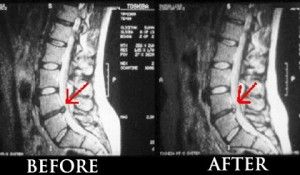Many times, back pain is caused from a sudden movement, lifting a heavy object, sitting in one position for long periods of time or from an injury or accident. Before the moment you feel the pain or injury, there is most often a pre-existing injury or loss of tissue strength and function in your spine.
The following is a list of common causes of low side back pain:
- Bulging or herniated discs
- Injury or overuse of muscles, ligaments, facet joints, and the sacroiliac joints.
- Muscle spasm (very tense muscles that remain contracted)
- Degeneration of the discs
- Poor alignment or fixations of the vertebrae
- Spondylolisthesis
- Osteoarthritis
- Spinal stenosis (narrowing of the spinal canal)
- Small fractures to the spine from osteoporosis
- Strain or tears to the muscles or ligaments supporting the back
- Spinal curvatures (like scoliosis or kyphosis), which may be inherited and seen in children or teens
Luckily, there is a non-invasive, safe alternative for treating back pain, spinal decompression. Non-surgical spinal decompression generates gentle pulling and positioning that allows the spinal discs to decompress, or reduce the pressure they are experiencing. Decompression produces a negative pressure that allows the injury to heal naturally within the disc. Non-surgical spinal decompression is effective in treating many conditions including back pain, leg pain, neck pain, sciatica, herniated or bulging discs, degenerative discs (arthritis), and posterior facet injuries.
Patients that undergo spinal decompression therapy are treated fully clothed. They may lie face up or face down depending on the recommendation from the doctor. This versatility allows us to set specific guidelines for your individual needs and condition. The patient is fitted with a comfortable harness that gently connects to your pelvis and another that is fitted to your thoracic area. The table is controlled by the doctor using a computerized console where the customized treatment protocol is entered into the computer. Each treatment last approximately 20 minutes.
Spinal Decompression is a very safe and effective treatment for back pain, leg pain and neck pain. Although no treatment is 100% successful, has a very high success rate with full compliance from the patient. There will be certain activities you are asked to avoid while you are going thru your treatment protocol. You will be prescribed specific active rehabilitation exercises designed to strengthen and stabilize your spine.
If you have further questions or know someone that would benefit from non-surgical spinal decompression, please contact our office at 360-705-0900, or click here to visit our website.
References
www.americanspinal.com/



